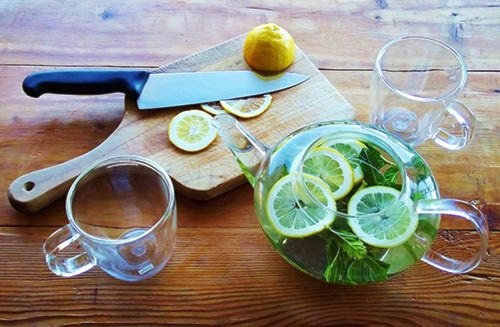Personally, I am more of a coffee guy, and when I want a perfect cup of ‘Joe,’ it’s usually as simple as freshly ground quality beans, a French pYouress and some boiling water.
Tea, on the other hand, can be such a crap shoot, as you never know if those blends of dried Camellia sinensis leaves or herbs in the paper sac are ever going to amount to much on the palate.
And when you consider how long those tea bags have been sitting in your cupboard, or on the grocery store shelf, at the wholesale supplier’s warehouse or the grower’s storage facility – it’s not difficult to surmise that your tea herbs are probably months old and have lost much of their true flavor.
So why not grow your own? You will definitely reap a fresher cup of tea and most of the herbs, like mint and lemon balm, are incredibly easy to cultivate.
Beyond that, the real benefits are that you control such unwanteds as pesticide residues, heavy metals (from contaminated soils) and food coloring.
So without further ado, here are your most common herbal tea options:
• Chamomile – there are essentially two species of chamomile, the perennial Roman chamomile (Chamaemelum nobile or Anthemis nobilis) and the annual German chamomile (Matricaria chamomilla). Teas made from fresh or dried flowerheads will aid insomnia and even help with arthritis symptoms.
• Lemon balm – the lemony-scented foliage of Melissa officinalis works well in both hot and cold teas, with the added benefits of calming upset stomachs and asthma. Like mint (which is related), lemon balm is quite invasive and should be grown in its own pot or garden section. Variegated and gold-leaved forms are also available.
• Beebalm – the leaves of Oswego tea, or Monarda didyma, have long been used as a pioneer beverage and it can be substituted for Bergamot orange (Citrus bergamia) as an Earl grey tea flavouring. This perennial is a common ornamental and often features bright red flowers that attract hummingbirds.
• Lemon verbena – the dried or fresh leaves of Aloysia triphylla make a tasty lemon tea that is popular in Spain and Portugal. Some people combine it with mint to make a hot tea that is sweetened with honey. Aids in weight loss, sleep disorders and digestive problems. Frost-tender.
• Sugar plant - Stevia rebaudiana is a frost-tender native of Paraguay whose leaves produce a sweetener 200-300 times sweeter than table sugar, and without all the calories. It can be used dried or fresh to sweeten teas and is a good choice for diabetics. Plant outdoors after all danger of frost has passed.
• Mint – there has been an explosion of mint cultivars in recent years, although the two most common are Peppermint (Mentha x piperita) and Spearmint (Mentha spicata). All are perennial in nature and are quite invasive, so be sure to give them their own space.
Other cultivars
• Ginger – A gold variegated mint with overtones of ginger flavor.
• Mojito – A strong mint hybrid from Cuba and a mojito essential.
• Swiss – A peppermint with a lighter, refreshing flavour.
• Orange – Makes a tasty cold beverage with orange juice and tea.
• Kentucky colonel – A cross of apple and spearmint, a key ingredient of the mint julep.
• Sweet lemon – A fruity mint for tea, bred from apple and lime mint.
• Chocolate – A true chocolate scent, like a Peppermint Patty.
• Apple – A tall growing mint with green apple-scented foliage.
• Candy – A peppermint with mouth-watering candy-flavored leaves.
• Moroccan – Used with green tea and sugar to create Moroccan tea.
Mike Lascelle is a local nursery manager and gardening author (hebe_acer@hotmail.com).
